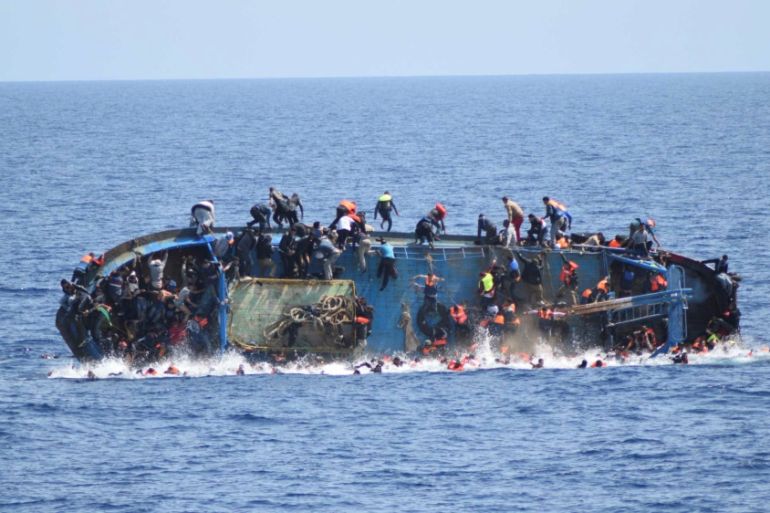Refugee deaths intensify call for safe EU passages
EU member states need to do more to prevent deaths as peak crossing season approaches, rights groups warn.

Rights groups and activists have urged the European Union to do more to protect refugees fleeing war and persecution after the recent deaths of scores trying to reach Europe in overcrowded boats.
In three consecutive days, from Wednesday to Friday, at least 65 people were reported to have drowned as three boats heading from the Libyan coast to Italy tipped over in the Mediterranean.
Keep reading
list of 4 itemsBeyond borders: Migrants online
Tunis police raid sees refugees abandoned near the border with Algeria
‘No turning back’: Carnation Revolution divides Portugal again, 50 years on
The Italian navy confirmed Friday’s incident on Twitter, saying that it had rescued 629 people and pulled 45 corpses from the sea, adding that the search would continue for any missing bodies.
|
|
The latest incidents have raised alarm among human rights groups and NGOs, who are urging EU member states to do more to protect the thousands escaping turmoil.
“The first thing to do is to ensure a robust search-and-rescue operation,” Judith Sunderland, associate director for Europe at Human Rights Watch (HRW), told Al Jazeera.
“We’re still pretty much at the start of peak crossing season. In the months ahead, far more work has to be done to prevent these deaths.
“Policy response has not been up to the challenge, even though we do have to recognise the much greater efforts in the past two years, since 2014.”
From January 1 to May 25 this year, at least 1,475 died making the journey to Europe by sea, according to the International Organization for Migration (IOM). This is an improvement over last year, when 1,828 refugees and migrants died in the first five months of 2015.
None of the deaths this month occurred on the eastern Mediterranean route between Turkey and Greece, where arrivals have slowed to a trickle since the EU struck a deal with Ankara to curb the flow.
HRW’s Sunderland said the EU’s naval mission in the Mediterranean – Operation Sophia – aimed at checking undocumented migration could be exacerbating the danger.
READ MORE: The booming fake passport market for refugees in Athens
“Action by Operation Sophia could have led smugglers to adapt their methods in ways that imperil people on these journeys even more than before,” explained HRW’s Sunderland, adding that more lives could be saved simply by using available data.
“The sea is a vast area, but most tragedies happen within a contained area, close to the North African coast. There is a lot of data and analysis out there to pinpoint where boats and the rescue and search operation are most needed.
“A lot of NGOs have responded in a very robust way [with rescue boats], which should be the responsibility of coastal states and the EU in solidarity.”
Smugglers from the Libyan coast are also increasingly using rubber rafts, which, as opposed to the relatively safer wooden boats, are more likely to leak gas, get punctured and sink, Sunderland said.
‘Ferries, not Frontex’
Alarmphone is one of the NGOs trying to help. The transnational network of activist and migrant groups is located on both sides of the Mediterranean and provides a 24-hour hotline for refugees in distress at sea.
“We still see [recent] fatalities where the exact number of drowned people is not clear because the EU is keeping up its border and visa regime, closing borders and erecting fences,” a spokesman from Alarmphone told Al Jazeera.
“Although the EU spends a lot of money on [the EU border agency] Frontex and border controls, they are not willing to spend money on saving refugees’ lives,” he added.
Last year, the group received distress calls from more than 1,200 boats.
OPINION: The EU can learn from Turkey’s refugee experience
“If only there were legal and safe migration routes, nobody would have to die at sea … In this sense, we say: ferries, not Frontex,” said the spokesman.
He added that the EU-Turkey deal, which effectively closed the eastern Mediterranean route, would spur more to find other ways to reach Europe.
Moreover, Niels Frenzen, director of the Immigration Clinic at USC Gould School of Law, said the EU-Turkey deal had lowered the sea-crossing death toll, but it was far too early to draw any conclusion, as the peak of the crossing season is yet to come.

Central Mediterranean route
Those travelling on the central Mediterranean route via Libya are largely from countries such as Nigeria, Gambia, Senegal, Guinea, and Ivory Coast, according to the IOM.
Syrians, Iraqis, Afghans, Pakistanis and Iranians, meanwhile, tend to use the Greece-bound route from Turkey.
“Increased border controls and increased militarisation do not solve the bigger problems faced by those people who are forced to move,” Frenzen said.
“And the closing of borders, detaining of migrants and asylum seekers, the focus on smugglers and destroying smuggler boats, are tactics that are not humanitarian or legal in nature.”
More than one million refugees arrived in Europe last year. With 3,771 deaths, 2015 was the deadliest year on record for migrants and refugees crossing the Mediterranean trying to reach Europe, the IOM has said.
By comparison, 3,279 deaths were recorded in the Mediterranean in 2014.
Follow Anealla Safdar on Twitter: @anealla